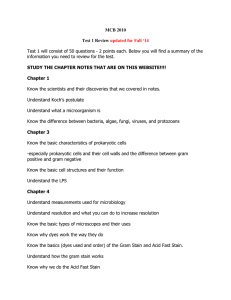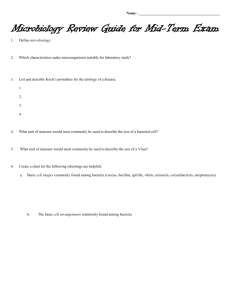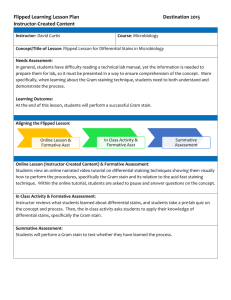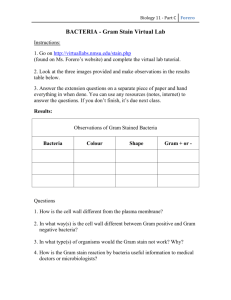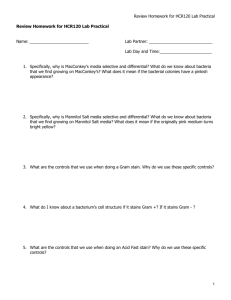Quality Control
advertisement
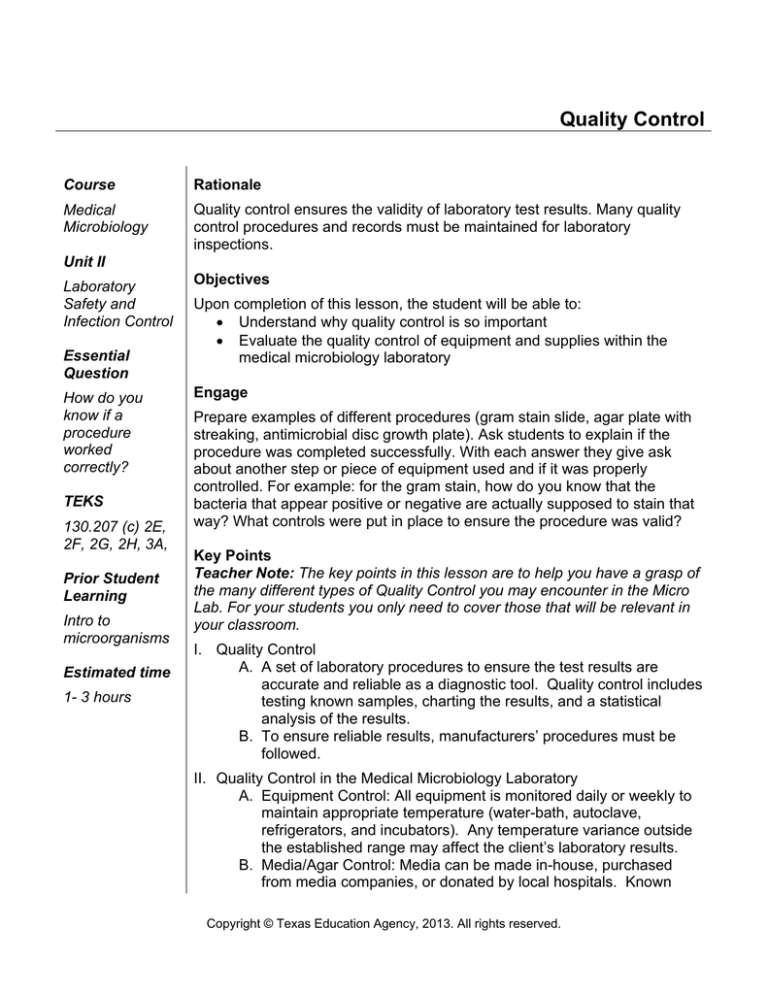
Quality Control Course Rationale Medical Microbiology Quality control ensures the validity of laboratory test results. Many quality control procedures and records must be maintained for laboratory inspections. Unit II Laboratory Safety and Infection Control Essential Question How do you know if a procedure worked correctly? TEKS 130.207 (c) 2E, 2F, 2G, 2H, 3A, Prior Student Learning Intro to microorganisms Estimated time 1- 3 hours Objectives Upon completion of this lesson, the student will be able to: Understand why quality control is so important Evaluate the quality control of equipment and supplies within the medical microbiology laboratory Engage Prepare examples of different procedures (gram stain slide, agar plate with streaking, antimicrobial disc growth plate). Ask students to explain if the procedure was completed successfully. With each answer they give ask about another step or piece of equipment used and if it was properly controlled. For example: for the gram stain, how do you know that the bacteria that appear positive or negative are actually supposed to stain that way? What controls were put in place to ensure the procedure was valid? Key Points Teacher Note: The key points in this lesson are to help you have a grasp of the many different types of Quality Control you may encounter in the Micro Lab. For your students you only need to cover those that will be relevant in your classroom. I. Quality Control A. A set of laboratory procedures to ensure the test results are accurate and reliable as a diagnostic tool. Quality control includes testing known samples, charting the results, and a statistical analysis of the results. B. To ensure reliable results, manufacturers’ procedures must be followed. II. Quality Control in the Medical Microbiology Laboratory A. Equipment Control: All equipment is monitored daily or weekly to maintain appropriate temperature (water-bath, autoclave, refrigerators, and incubators). Any temperature variance outside the established range may affect the client’s laboratory results. B. Media/Agar Control: Media can be made in-house, purchased from media companies, or donated by local hospitals. Known Copyright © Texas Education Agency, 2013. All rights reserved. C. D. E. F. stock cultures are used to check for growth and correct biochemical reactions of the media. Reagent Control: Reagents used should be tested utilizing positive and negative controls. The quality of gram stain reagents is checked with known bacterial cultures. Antimicrobial Disc Control: All antibiotic susceptibility discs should be checked against known bacterial cultures and the sensitivities compared with the manufacturer’s results. Stock Culture Control: Cultures themselves must be tested periodically to ensure viability and performance. (If results are erroneous, it is probably the stock culture that needs further investigation.) Specimen Collection and Control: Protocols must be followed for proper collection of client’s specimens. III. Summary A. Laboratory results are not acceptable if the quality control is not within established parameters. What is the correct course of action to follow when QC is out of range? It depends greatly on the procedure and the QC. 1. For example if a refrigerator is found to be too warm items can be moved to a second fridge until the first is brought back in range. 2. If the failed QC is a gram stain control slide staining gram positive instead of gram negative then trouble shooting should be done. 3. Explain to students how and why you would troubleshoot situations in general or as they come up. For this gram stain example the person staining probably forgot to use the decolorizer so the crystal violet did not leave the cells. This is a great topic to discuss with your class as you get to each new procedure so they begin to understand why QC is important and how to troubleshoot as needed. Teacher Note Local hospitals may give you outdated material and it may be appropriate for use in the high school laboratory. Explain to students why this is an acceptable practice for education but not for health care. Control strains of bacteria are available through biological companies. Activity I. Create a quality control program, in cooperative groups, for a testing procedure performed in the laboratory. Design a multimedia presentation. Copyright © Texas Education Agency, 2013. All rights reserved. II. Evaluate the quality control already being used in your classroom lab. Have students check lot numbers and expiration dates. Students can be responsible for recording thermometer readings for incubators, water baths and room temperature. This activity can be done in a scavenger hunt during one class or to establish a routine used throughout the semester. Assessment Multimedia Rubric Materials Multimedia equipment Examples of procedures done in your lab: Gram stain slide Agar plates Thermometers in incubators, water baths, and room temperature Antimicrobial disc plates with growth Reagents commonly used to check expiration dates Accommodations for Learning Differences For reinforcement, the student will visit a medical microbiology laboratory and write a report to describe the quality control program and how it may affect the health consumer. For enrichment, the student will research and present a case study involving the lack of quality control. National and State Education Standards National Health Science Cluster Standards HLC06.01 Health care workers will understand the existing and potential hazards to clients, co-workers, and self. They will prevent injury or illness through safe work practices and follow health and safety policies and procedures. TEKS 130.207 (c) 2 (E) plan and implement descriptive, comparative, and experimental investigations, including asking questions, formulating testable hypotheses, and selecting equipment and technology; 130.207 (c) 2 (F) collect and organize qualitative and quantitative data and make measurements with accuracy and precision using tools such as calculators, spreadsheet software, data-collecting probes, computers, standard laboratory glassware, microscopes, various prepared slides, stereoscopes, metric rulers, electronic balances, hand lenses, Celsius Copyright © Texas Education Agency, 2013. All rights reserved. thermometers, hot plates, lab notebooks or journals, timing devices, Petri dishes, lab incubators, dissection equipment, meter sticks, and models, diagrams, or samples of biological specimens or structures; 130.207 (c) 2 (G) analyze, evaluate, make inferences, and predict trends from data; and 130.207 (c) 2 (H) communicate valid conclusions supported by the data through methods such as lab reports, labeled drawings, graphic organizers, journals, summaries, oral reports, and technology-based reports. 130.207 (c) 3(A) in all fields of science, analyze, evaluate, and critique scientific explanations by using empirical evidence, logical reasoning, and experimental and observational testing, including examining all sides of scientific evidence of those scientific explanations, so as to encourage critical thinking by the student; Texas College and Career Readiness Standards Math IV Measurement and Reasoning A1 Select or uses the appropriate unit for attribute being measured. B1 Convert from one measurement system to another. Science-Nature of Science: Scientific Way of Learning and Thinking C2 Understand and apply safe procedures in the laboratory and field, including chemical, electrical, and fire safety and safe handling of live or preserved organisms. Science-Foundation Skills: Scientific Applications of Communication C1 Prepare and present scientific/technical information in appropriate formats for various audiences. English-Writing A2 Generate ideas and gather information relevant to the topic and purpose, keeping careful records of outside sources. Copyright © Texas Education Agency, 2013. All rights reserved. TemperatureRecordChartfor:__________________________ March April May June July Comments: 1 2 3 4 5 6 7 8 9 10 11 12 13 14 15 16 17 18 19 20 21 22 23 24 25 26 27 28 29 30 31 Day August February January December November October September Year:_____________ Copyright © Texas Education Agency, 2013. All rights reserved. Quality Control Scavenger Hunt Name: ________________________ Date: ______________ Class: ______________ Complete the following with data from your classroom Reagent Lot Expiration Date 1. ____________________ ______________ ________________________ 2. ____________________ ______________ ________________________ 3. ____________________ ______________ ________________________ 4. ____________________ ______________ ________________________ 5. ____________________ ______________ ________________________ Thermometer Location Reading 1. _____________________________ ____________ 2. _____________________________ _____________ 3. _____________________________ _____________ Describe other quality control measures used in your classroom. Remember to write in complete sentences. Copyright © Texas Education Agency, 2013. All rights reserved.
